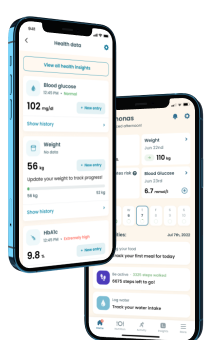Gestational Diabetes: Prevention, Diet, and Recipes

You probably came across this article for one of the two reasons.
You have either been diagnosed with gestational diabetes by your doctor and you want to learn more about the condition.
Or you might be getting ready for pregnancy and want to take safety cautions if you feel like you’re in the “danger zone.”
Whatever the reasons are, you came to the right place. Gestational diabetes might seem like a scary diagnosis, but the good news is – you’re in full control of it.
In 80-90% of the cases, only the right diet and moderate amount of exercise are enough to ensure you’re going to give birth to a perfectly healthy baby.
Of course, a gestational diabetes diet, especially during pregnancy, when food cravings get so intense isn’t the easiest to implement.
But, when it comes to ensuring good health for yourself and your loved ones, it’s not a place to make compromises. That’s why we prepared nutrition tips that will benefit you and your baby in so many ways possible.
What is Gestational Diabetes?
Gestational diabetes is a type of diabetes that affects pregnant women only. The condition most commonly develops in the second or third trimester, but it can also develop sooner.
The same as other forms of diabetes, it affects the body’s ability to regulate blood sugar levels. Gestational diabetes develops because the hormones released during pregnancy sometimes affect insulin production.
Therefore, the body fails to produce enough insulin and meet extra pregnancy needs.
This leads to high blood sugar levels – hyperglycemia.
According to the Centers for Disease Control and Prevention, 2% to 10% of pregnant women in the United States are affected by this condition.
The good news is the blood sugars usually return to normal after delivery, although an increased risk of developing type 2 diabetes later in life remains.
Is Gestational Diabetes Dangerous?
In most cases, women with gestational diabetes carry perfectly healthy babies. However, if the condition is not treated some complications might arise:
- Baby can grow more than usual. Extra blood sugar in the mom’s blood can be transferred to the baby through the placenta, leading to higher than normal birth weight. This then can lead to complicated labor (extra blood and pain, induced labor, or even cesarean section).
- Too much amniotic fluid. This is called polyhydramnios. It’s an excess amount of the fluid that surrounds the baby in the womb. It can cause premature labor and delivery problems.
- Pre-eclampsia. This condition causes high blood pressure and if not treated, can lead to pregnancy complications.
- Childbirth injuries and other disorders. Heavy baby weight increases the risk of childbirth injuries. For example, if the baby has low blood sugar during birth, a condition called jaundice can develop.
- The loss of your baby. We must note that this is very rare. Don’t get scared and remember that you are in full control of the condition.
- Type 2 diabetes. Women who have gestational diabetes are more likely to develop type 2 diabetes in the future.
Signs You Might Have Gestational Diabetes
Usually, gestational diabetes doesn’t have any obvious signs. Most women find out if they have a condition at the end of the second trimester when a doctor takes a blood test to see if the blood sugar levels are in the norm.
However, sometimes a pregnant woman can experience some specific symptoms, such as dry mouth and constant thirst.
The woman can also experience symptoms such as frequent urination and fatigue. The tricky part is these symptoms are common among pregnant women, and it’s hard to tell whether it is caused by the condition or not.
So a blood test is always needed to make sure.
Risk Factors and Prevention
Risk factors for developing gestational diabetes:
- being overweight (BMI 25-30) or obese (BMI > 30)
- having gestational diabetes during past pregnancies
- previously giving birth to a >10 lbs child
- having a family history of the condition
As we said in the beginning, in 80-90% of cases, gestational diabetes can be controlled with the right diet and moderate exercise. If you can apply at least one of the risk factors for yourself and you’re only starting to plan your pregnancy, we advise you to take some steps now. Try reaching a healthy body weight and feel free to follow the dietary guidelines we’ll cover in the next section.
Gestational Diabetes Diet Plan
First, let’s talk about some general nutritional guidelines.
You should include enough complex carbs, a moderate amount of protein, and fat in your diet. But most importantly, you should avoid consuming too many simple carbs – sugars.
Complex carbs are also called polysaccharides. Complex carbohydrates include starch, which is found in whole grains, legumes, and vegetables as well as dietary fiber, which is found in brown rice, fruits, and of course, legumes and vegetables.
Since carbohydrates are the main source of energy, contrary to popular dietary myths, you don’t have to avoid them as much as you think you have to. In fact, carbohydrates should make up 50% of your diet.
Simple carbs, or monosaccharides, however, should be avoided. Simple carbs include sucrose (most of which comes from refined sugar), fructose in fruits, and lactose in dairy products. The last two are okay to consume in moderate amounts. However, refined sugars are better to avoid.
Generally, you should reach for 6-8 servings of carbs per day. One serving equals 1 slice of bread / ½ cup of cooked rice / 1 English muffin.
Dietary guidelines for gestational diabetes
Eat a good nutritious breakfast
Eating a nutritious breakfast will help to balance your morning glycemia (concentration of sugar or glucose in the blood). Porridge is a perfect option for breakfast as it contains complex carbs. The body digests and absorbs energy from them gradually, meaning your blood sugar levels won’t spike, and you’ll feel energized for longer.
Other whole-grain products (such as dark/rye bread) and protein products such as poultry, eggs, and low-fat yogurt are also good options.
Eat regularly
Eating regularly is very important to avoid sugar/food cravings. Try eating every 3 hours.
Also, be smart about carb distribution. You might want to eat more carbs during the first part of the day when you need more energy and chose protein and veggies in the evening. Also, try to eat the same amount of carbohydrates, protein, and fat every day. This will help to keep your blood sugar levels stable.
Pay attention to the Glycemic Index
Glycemic Index is a number that shows food’s ability to spike your blood sugar levels two hours after consumption. 100 is equivalent to pure glucose. Foods that have GI under 55 are considered a better option for people with diabetes.
Foods with a low GI (<55) include minimally processed grains, whole grain pasta, lentils, most fruit, vegetables, beans, low-fat dairy foods, and nuts.
Foods with medium GI (56-69) include white rice, couscous, corn, sweet potatoes, and breakfast cereals.
Foods with high GI (70-100) include potatoes, white bread, white (short-grain) rice, and sugary junk food.
Needless to say, you should reach for the lower GI foods. Just switching white rice to brown or regular potatoes to sweet ones can make a huge difference.
Also, it’s really important how the food is prepared. Potato is a really good example of how the cooking method can alter the glycemic index. Boiled potatoes have a GI of 59, while mashed or instant potatoes have a GI of as high as 82.
Avoid consuming sugar
Sugary junk food, pastries, chocolate, candy, and sodas are a big no. It makes your sugar levels spike and doesn’t leave you satiated for long. So don’t forget to always check food labels to see what part of carbs is sugar.



Don’t forget the dietary fiber
Choose foods high in dietary fiber. These include whole grains (oats, buckwheat) fruit (apples, bananas, oranges, strawberries), and especially vegetables (beans, peas, broccoli, brussels sprouts). Eating fiber daily will smooth your digestive process.
Eat enough vegetables
Low-carb veggies, such as greens, carrots, tomatoes, zucchini, peppers, and mushrooms are a perfect source of fiber and nutrients. You should reach for consuming at least 500 grams of veggies daily. Eating veggies with every meal of yours will help you feel satiated for longer and will reduce food cravings.
Drink more water
The importance of drinking water is stressed so much but still often forgotten. Drink at least ten 8-ounce cups of water each day. Don’t worry if you feel like you need a little more or less, as every woman’s needs differ. Also, feel free to drink sugarless tea with lemon and moderate amounts of juice mixed with water.
Exclude saturated fat
Reduce your fat intake, especially saturated fat. Change the butter to vegetable oil, separate visible fat from meat, and try to cook the dishes using as little oil as possible. However, feel free to include good fats in your diet, such as avocados. Eggs, fatty fish, nuts, and seeds.
Include exercise
Well, this one is not really about the diet. But it’s still as important. Contrary to what some pregnant women think (or in often cases, to what people surrounding them think), exercising is by no means forbidden.
It is, in fact, recommended. The exercise can be as light as taking a 20-minute walk after a meal. It will already do wonders in helping you balance your sugar levels.
Eat:
- lean meat (beef, chicken, turkey)
- fish
- seafood
- beans
- cheese
- eggs
- vegetables
- moderate amounts of fruit (citrus fruits, such as oranges, grapefruits, and tangerines should be your go-to)
- nuts
- tofu
- Greek yogurt
Skip (or consume in very limited amounts):
- french-fries
- potatoes
- pasta (whole grain is fine)
- white rice
- white bread
- pastry
- fruit juice
- cookies
- corn
- sweetened yogurt
- candy
- soda
FAQ
How to prevent gestational diabetes?
We cannot provide you with a 100% reliable method.
But we can assure you that a healthy lifestyle will lower the chances of developing the condition to a minimum.
If you think you’re in the “danger zone,” following the diet tips given above, exercising, and doing your best to reach a healthy weight is all you can do for now.
The good news is that it will most probably be enough to ensure a healthy, GD-free pregnancy.
How to control gestational diabetes with the Indian diet?
First of all, let’s talk about what gestational diabetes and an Indian diet have in common.
Apparently, gestational diabetes rates in India are shockingly high.
Prevalence of the condition varies between3,8% in Kashmir, 6,2% in Mysore, and 9,5% in Western India, and rates as high as 35% in Punjab and 41% in Lucknow.
So it’s not like there is one unified Indian diet you could follow. But, Indian women, in fact, have come up with various nutritious, tasty, and gestational diabetes-friendly meal options.
We thought, why not share some ideas with you?
Also, don’t be shocked by the number of ingredients as Indian cuisine tends to include a lot of different spices.
Gestational Diabetes-Friendly Recipes
Vegetable Patties with Roasted Chickpeas
This will make a perfect low-carb snack. Feel free to carry these with you as they are also really good served cold.
Ingredients:
- 1 cup cauliflower (cut into florets)
- 1/2 cup broccoli (cut into florets)
- 20 French beans (finely chopped)
- 1/4 cup butternut squash (cubed)
- 3 cups roasted chickpeas (pottu kadalai) (can be found in Indian grocery stores)
- 1 small onion (finely chopped)
- 1/4 cup cilantro (finely chopped)
- 1 tablespoon ginger-garlic paste
- 1 teaspoon turmeric powder
- 1 teaspoon chili powder
- 1 tablespoon coriander powder
- 1/2 tablespoon cumin powder
- 1 teaspoon garam masala
- 1 tablespoon Kasuri methi / dried fenugreek leaves
- 1 tablespoon olive oil
- Salt to taste
- 5 cups water to cook the vegetables in a pan (or use minimum water to steam cook them)
- 1/4 cup oil to cook the patties
How to:
- Dry roast the chickpeas in a saucepan for 2-3 min on medium-low flame. Then, cool it down and grind it to a smooth powder.
- Boil the chopped vegetables (except the onions) covered for 15 minutes. Drain through a colander and set aside.
- Using a masher or a food processor, pulse them together. You want them to mix and be lump-free.
- Add the cooked vegetables to a fresh bowl. Then add the onions, ginger-garlic paste, cilantro, spice powders, Kasuri methi, and salt. Mix with hand or spatula.
- Slowly add roasted chickpeas powder to the veggie mixture. Let it sit for about 15 minutes. Store the remaining the powder (if any) for future use.
- Roll into balls of the desired size and make a patty out of it.
- Heat a non-stick saucepan and cook each side for 3-5 minutes
- Serve hot with pickled onions and yogurt dip.
Spinach Chicken Curry
When it comes to Indian cuisine, curry is hard to miss. Check out this easy-to-make, diabetes-friendly recipe.
Ingredients:
- 2 tablespoon olive oil
- 1 large red onion (diced)
- 4 garlic (minced)
- 1-inch ginger (minced)
- 2 pounds chicken (boneless, skinless)
- 1 pound baby spinach
- 1 teaspoon chili powder
- 1 tablespoon coriander powder
- 1 teaspoon garam masala
- Salt to taste
How to:
- Clean and wash the chicken. Chop it to about 0,4-0,6 inch cubes. Set aside.
- Wash the spinach. Then drain the excess water with a paper towel.
- Heat oil in a cooking pan on medium flame. Then add the onions with a little salt. Let the onions “sweat”. Then add the ginger, garlic and cook it all together for 3 to 5 minutes.
- Add the chicken, garam masala, chili, and coriander powder. Cook for 10 minutes. Don’t add any water, as the chicken should release its own water to the pan.
- Pour the spinach on top, stir and cook covered for 25-30 minutes. Adjust salt to taste.
- Serve hot with brown rice or a whole-grain tortilla.
Indian Style Cauliflower Soup
Soups are totally underrated. They are easy to make, low-carb, and nutritious.
Ingredients:
- 1 small cauliflower (cut into small florets)
- 1/2 inch ginger (minced)
- 1 garlic clove (minced)
- 1 small onion (chopped)
- 1 teaspoon chili powder
- 2 teaspoon coriander powder
- 1 cup fat-free sour cream
- 1/2 cup cilantro (chopped)
- 3 cups low sodium chicken stock or water
- Salt to taste
- Pinch of garam masala for garnish
- Olive oil to saute
How to:
- Heat olive oil in a large saucepan. Add the garlic and ginger. Saute for 30-45 seconds.
- Throw in the onions and cook for 3-5 minutes. Add the chili and coriander powder and cook for approximately 1-2 minutes. Add the cauliflower and mix well.
- Pour the chicken stock and bring it to a boil. Cook for 20 minutes.
- Turn off the flame and blend everything in a food processor to a smooth paste.
- Add the sour cream and coriander. Mix well. Add little water if you find the consistency too thick.
- Garnish with garam masala and serve a whole grain tortilla or toast.
TIP: if you want to make the soup more nutritious and satiating, feel free to add and process 3-5 oz of boiled chicken breast in step 4.
Conclusion
Pregnancy is a challenging period in one’s life. It can be the most complicated, especially if you have to deal with a diagnosis such as gestational diabetes. But it can also bring you so much joy and teach you the most important lessons.
Don’t get scared by the diagnosis. Just following some diet guidelines, such as excluding refined sugars, including whole-grain products, protein, good fats, veggies, and lots of water together with exercising a little will put you in control of the condition.
Think of it this way – following the right diet will not only ensure a complication-free delivery but also help you stay healthy and gain less pregnancy weight. You’ve got this!
Take a quiz and get your diabetes-management plan today!








